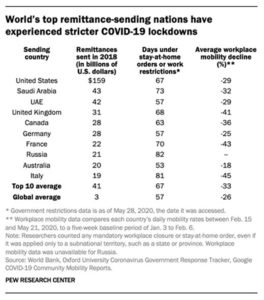Sharp decline in remittances expected in 2020 – study
Remittances, or money sent home by migrants, are expected to fall by a record 20 per cent this year, according to a new data.
The drop in remittances from a high of $US714 billion in 2019 to an estimated $US572 billion in 2020, comes as the world’s largest remittance-sending nations have experienced COVID-19 driven lockdowns, according to data from the World Bank, and Oxford University.
 The Washington-based think tank, the Pew Research Centre, analysed the data and concluded that the 10 countries that sent 61 per cent of the world’s remittances in 2018 have spent an average of 10 more days under COVID-19 related lockdowns – and experienced greater declines in physical mobility near workplaces – than other countries.
The Washington-based think tank, the Pew Research Centre, analysed the data and concluded that the 10 countries that sent 61 per cent of the world’s remittances in 2018 have spent an average of 10 more days under COVID-19 related lockdowns – and experienced greater declines in physical mobility near workplaces – than other countries.
The report says this will have an outsize effect on the countries that depend heavily on these nations for remittances.
The Pew Centre examined two measures of workforce activity in remittance-sending countries: the number of days each country has spent under stay-at-home orders or workplace closures in 2020; and the average decline in physical mobility near workplaces during the pandemic.
“Together, these indicators paint a portrait of declining economic activity around the globe, especially in the world’s 10 largest remittance-sending countries,” the report said.
 Thee ten countries analyses experienced an average 33 per cent decline in physical mobility around workplaces between February 15 and May 21, compared with a 26 per cent decline among the other 116 countries or territories for which data is available.
Thee ten countries analyses experienced an average 33 per cent decline in physical mobility around workplaces between February 15 and May 21, compared with a 26 per cent decline among the other 116 countries or territories for which data is available.
The same top remittance senders experienced an average of 67 days under workplace closures or stay-at-home orders as of May 28, compared with an average of 57 days for the other 154 countries or territories for which data is available.
“Some countries stand out for receiving an unusually large share of their gross domestic product in remittances from countries that have experienced heavy declines in mobility,” the report said.
“For instance, 17 per cent of GDP in the Palestinian territories came from remittances in 2018, with most of that money arriving from countries that have experienced especially large declines in mobility near workplaces this year. Jordan, which implemented one of the world’s strictest COVID-19 lockdowns in late March, sent about $US1 billion in remittances to the Palestinian territories in 2018.
 “Other countries that could be hit hard are among the world’s most dependent on remittances. For example, Haiti’s $US3.1 billion in annual remittance inflows accounted for 33 per cent of its GDP in 2018, making it the world’s third most remittance-dependent country that year, after Tonga and Kyrgyzstan. Of Haiti’s 2018 total, one-third (equal to 11 per cent of GDP) came from countries that experienced large declines in workplace mobility this spring,” the report said.
“Other countries that could be hit hard are among the world’s most dependent on remittances. For example, Haiti’s $US3.1 billion in annual remittance inflows accounted for 33 per cent of its GDP in 2018, making it the world’s third most remittance-dependent country that year, after Tonga and Kyrgyzstan. Of Haiti’s 2018 total, one-third (equal to 11 per cent of GDP) came from countries that experienced large declines in workplace mobility this spring,” the report said.
The Pew Centre said it was not unusual for worldwide remittances from migrants to ebb and flow with economic circumstances in sending countries.
In 2009, during the Great Recession, global remittances declined 5 per cent as economies shrank. And in 2016, remittances fell 1 per cent, driven by weak growth in many countries and declining oil prices.
Remittances can also increase during hard times in migrants’ home countries. For example, remittances to Yemen more than doubled between 2011 and 2019 amid a civil war in that country.












